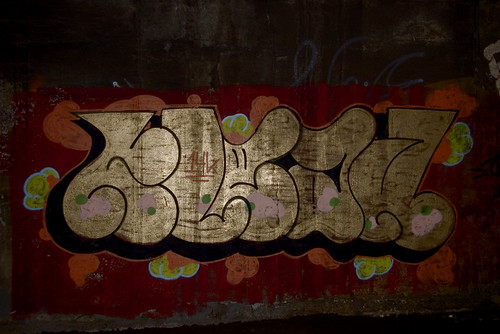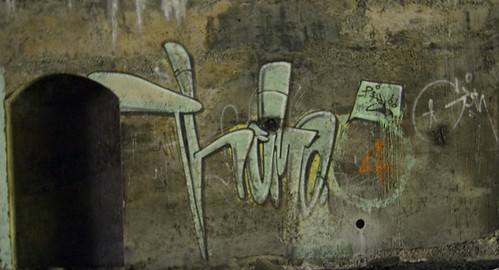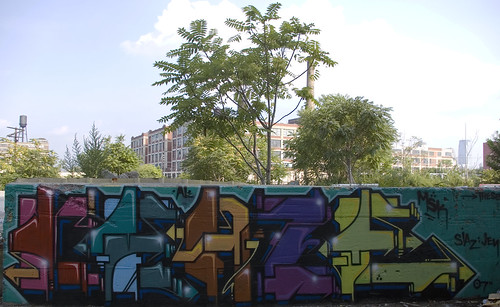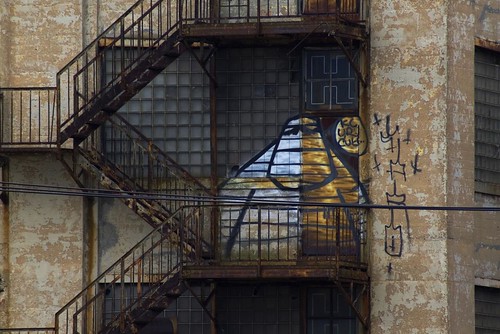I’ve been doing quite a bit of writing about digital humanities recently, but from a particular point of view. Not only has my writing been about DH and literature, which is only one domain for digital humanities, but I’ve been arguing a point that is largely unexplored in the DH literature, that computing itself is a source of theoretical insight and inspiration. While I intend to keep on with that, I thought I’d change things up a little and ride DH on a different hobbyhorse: graffiti.
By graffiti I don’t mean any and all writing on walls, but a certain tradition, one that started pretty much in Philadelphia and New York City in the late 1960s and 1970s and had gone around the world two decades later. As far as I know it’s the only form of non-representational art that’s reached a mass audience.
Graffiti is an outlaw form, making it particularly to those humanists who regard their opposition to The System as a central attribute of their vocation. For graffiti writers typically paint on someone else’s walls, and without permission. They are thus vandals, and some of them have done jail time on that account.
One effect of graffiti’s outlaw status is that photography had become incorporated into the graffiti work-style by the 1980s. In the early years the most intense work took place on the cars and in the stations, layaways, and yards of the New York City subway systems. The system would remove or paint-over graffiti on the cars – “buff” in graffiti parlance. So, the writers would bomb a car during the night and, the next day when the car would go out on a train, they’d wait for it to roll by, camera in hand. They’d snap a photo and so have a record of their work. In a day or three or a week or two the system would buff the car and the graffiti would be gone. But the writer, and his friends and colleagues (very important), would have a photographic record of the work. It wasn’t completely lost.
It’s thus no surprise that when the web went live graffiti writers where there to post their photos. In September of 1994 Susan Farrell brought Art Crimes to the web, the first web site devoted to graffiti. The site still exists, and in its original Web 1.0 format. It has graffiti photos from around the world, links to other graffiti sites, and links to interviews, articles and other materials about graffiti.
It is a graffiti resource. It is digital humanities before the term was coined, though not before humanists availed themselves of computer tech. Of course, it’s not sponsored by a university, museum, or research institute, and Susan Farrell isn’t a doctorate-carrying scholar. But that’s secondary. And the fact that Farrell and her site aren’t academic-legit probably gives her street cred that would come harder to an Ivy-League Consortium for Graffiti Studies – though probably not much harder, except that anyone now entering the game is rather late to the party.
There is, of course, lots of graffiti on the web. You can find links to other sites at Art Crimes. There are of course, Wikipedia articles – more civilian scholarship. Graffiti websites abound, and photo websites have graffiti photos. I post mine on Flickr, which has many groups devoted to graffiti.
So, the web abounds in graffiti. Digital humanities just oozing out of every pore, a virtual garden of graffiti goodies. And it’s not external to the world of graffiti writers. They take pictures themselves, and follow the art online. Here’s a bit from Cedar Lewisohn’s interview with Futura 2000 (Abstract Graffiti, 2011, pp. 67):
[Lewishon] The distribution of imagery is one of the biggest changes for graffiti.[Futura 2000] Now that we have this international medium, the internet, you can see images from every city, and it’s given the community a reference to draw from.Is it possible to distinguish between graffiti from different cities? Is there a difference between work from, say, London and Paris?You used to be able to do that. Everything was more isolated. In America, in particular, there was total style between what the Latinos and Californians were doing. They had their own calligraphy. But the graffiti that’s been exported to Europe and ultimately the world is still based on the same kind of style.
Thus, graffiti goes up on a Brooklyn wall on day 1. A photographer drops by on day 2 and photographs it, say, in the early afternoon. It goes out on the web in the evening, where it’s transmitted around the world, instantly. On day 3 similar designs are going up in Sao Paulo, Sydney, and Osaka. There we have it: 1) paint to wall, 2) image to camera, 3) image to web, 4) similar to to other wall. A complete circuit. A new aesthetic ecosystem. No, a new KIND of aesthetic ecosystem, one dependent on reproduction as no other has been.
That, it seems to me, is something a humanist would want to think about. That, and the fact that graffiti is vandalism, but also in museums, and mostly but by no means entirely male, is the unofficial art style of hip-hop ... that’s only the beginning.
❖ ❖ ❖
I’ve posted quite a bit about graffiti. The “graffiti” tag should get you just about everything, from posts containing only a photo or several to long-form essays. “Graffiti detail” links to posts with close-up shots of parts of larger graffiti pieces. I have a particular interest in graffiti sites, where you find multiple works by many writers, as a privileged locus for analysis. The Bergen Arches is one such site in Jersey City, and something I call the Urban Design Center is another.





No comments:
Post a Comment